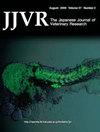Fate and tissue depletion of nivalenol in ducks
IF 0.3
4区 农林科学
Q4 VETERINARY SCIENCES
引用次数: 0
Abstract
Nivalenol (NIV), a mycotoxin belonging to the trichothecenes type B group, has recently been identified as causing one of the more potent toxicities among mycotoxins of this group. The purpose of this study was to clarify the toxicokinetics, and residues of NIV in ducks. Then, NIV was administered intravenously (iv) or orally (po) to ducks at a dosage of 0.8 mg/kg body weight. The concentrations of NIV in plasma and various tissues were quantified using liquid chromatography tandem-mass spectrometry. The plasma concentrations of NIV were measurable up to 12 h after iv and po administrations, respectively. A non-compartmental model was used to describe the toxicokinetics of NIV in ducks. The values of elimination half-life and volume of distribution were 2.24 ± 0.34 h and 1081.87 ± 306.56 ml/kg, respectively, after iv administration. The absolute oral bioavailability was 8.91 ± 1.69%. NIV was measurable in the vital organs after po administration. These results suggest that NIV is not favorably absorbed from the gastrointestinal tract, but it has the ability to penetrate into the various tissues of ducks.鸭雪缬醇的命运和组织耗损
雪腐镰刀菌醇(nivalol, NIV)是一种真菌毒素,属于毛霉烯类B型真菌毒素,最近被确定为引起该组真菌毒素中较强的毒性之一。本研究的目的是阐明NIV在鸭体内的毒动学和残留。然后,以0.8 mg/kg体重的剂量给药给鸭静脉(iv)或口服(po)。采用液相色谱串联质谱法测定血浆和各组织中NIV的浓度。分别在静脉和静脉给药后12小时可测量血浆NIV浓度。采用非室室模型描述了NIV在鸭体内的毒性动力学。静脉给药后的消除半衰期和分布体积分别为2.24±0.34 h和1081.87±306.56 ml/kg。绝对口服生物利用度为8.91±1.69%。给药后主要脏器的NIV可测量。这些结果表明,NIV不能很好地从胃肠道吸收,但它有能力渗透到鸭的各种组织中。
本文章由计算机程序翻译,如有差异,请以英文原文为准。
求助全文
约1分钟内获得全文
求助全文
来源期刊
CiteScore
1.00
自引率
0.00%
发文量
0
审稿时长
>36 weeks
期刊介绍:
The Japanese Journal of Veterinary Research (JJVR) quarterly publishes peer-reviewed articles on all aspects of veterinary science. JJVR was originally published as a “University Journal” of veterinary science at Hokkaido University from more than 60 years ago. Currently, JJVR, is Japan’s leading scientific veterinary journal, and provides valuable information for the development of veterinary science by welcoming contributions from researchers worldwide.
JJVR offers online submission for Regular Papers, Short Communications, and Review Articles that are unpublished and not being considered for publication elsewhere. Research areas include:
Anatomy, Physiology, Biochemistry, Pharmacology, Microbiology, Infectious diseases, Parasitology, Laboratory Animal Science and Medicine, Internal Medicine, Surgery, Pathology, Theriogenology, Molecular Medicine, Public Health, Radiation Biology, Toxicology, Wildlife Biology and Medicine, Veterinary Hygiene, The other fields related to veterinary science.

 求助内容:
求助内容: 应助结果提醒方式:
应助结果提醒方式:


